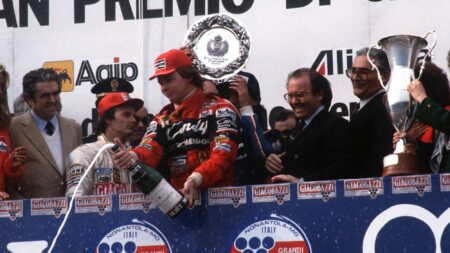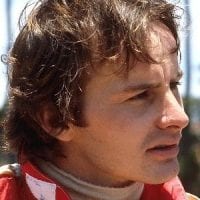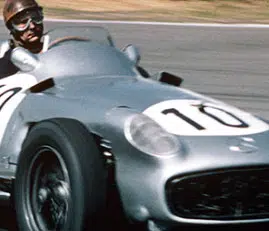What constitutes a great? Is it results, or is it championships won? If either is the answer, then why is Gilles Villeneuve the most loved driver of his generation? His sideways, aggressive driving style and refusal to give up thrilled Formula 1 for just four complete seasons. Villeneuve’s death left a deep scar on the sport but released a legend.
Background and early racing career
The son of a piano-tuner, Villeneuve turned his back on music in favour of cars at an early age. He competed in drag racing and snowmobiles before saving enough money to buy a two-year-old Formula Ford with which he promptly won the local championship.
Stubborn and single-minded, he funded his 1974 Formula Atlantic season by selling the family home apparently without discussing it with his wife. The gamble appeared to have backfired when he broke his left leg at Mosport Park. Villeneuve returned with his own team and immediately won in the rain at Gimli. His growing reputation as a fast but crash-prone talent took on international dimensions when he raced against visiting stars Jean-Pierre Jarier and Patrick Depailler at Trois-Rivières in 1975.
Dominant in both winter snowmobiling and North American Formula Atlantic Championships during 1976, Villeneuve was invited to join Ron Dennis’s Project Four Formula 2 team at Pau. A noteworthy 10th on the grid, the F1 fraternity took notice when he beat James Hunt at Trois-Rivières that autumn.
Formula 1 debut for McLaren
McLaren signed Villeneuve on Hunt’s recommendation to drive a third McLaren M23-Ford in the 1977 British Grand Prix at Silverstone and his debut was nothing short of spectacular. He qualified ahead of regular number two driver Jochen Mass in ninth position despite driving an older car and he was fast in the race in between several spins.
Switch to Ferrari
Ferrari were impressed and Villeneuve replaced Niki Lauda for the last two races of the season. However, his Ferrari 312T2 collided with Ronnie Peterson’s six-wheel Tyrrell during the Japanese GP with tragic consequences. Villeneuve’s car barrel-rolled off the track and two spectators who had strayed into an unauthorised area were killed.
Villeneuve began his first full F1 season erratically but with an obvious turn of pace. He dominated at Long Beach before crashing into Clay Regazzoni’s Shadow-Ford while lapping him and lost a second place finish at Monza for jumping the start. However, 1978 ended with an emotional first victory in the wet Canadian GP after Jean-Pierre Jarier’s Lotus-Ford had retired.
Joined at Ferrari by Jody Scheckter for 1979, it was the year in which Villeneuve tamed his wild side and became recognised as the quickest driver in the field. Early back-to-back victories in South Africa and Long Beach gave him the world championship lead and he starred in Belgium before running out of fuel on the last lap.
Scheckter won that day and the balance of power within the team changed. Villeneuve eventually supported his team-mate’s successful championship challenge and finished as runner-up. He ended the year just four points behind Scheckter – a margin that equated to the third place finish he lost in Belgium.
As memorable as the wins (that also included the Race of Champions at Brands Hatch and United States GP) were his performances in France and Holland. His French GP wheel-to-wheel duel with René Arnoux over second position and his determination to return to the Zandvoort pits following a puncture with a wheel trailing behind his Ferrari were criticised in some quarters but only served to further cement his place in the public’s affection – they helped write the Villeneuve legend.
Final Ferrari years
However, 1980 was hampered by that year’s woeful Michelin tyres and developing Ferrari’s new turbocharged engine. The Ferrari 126CK was all power and no handling in 1981 but Villeneuve scored his last two, and finest, victories with it. He held off Alan Jones in a thrilling climax in Monaco and the Spanish GP that followed is etched in the memory of every F1 fan of a certain age. Villeneuve kept four quicker cars in his slipstream for the final 20 laps to win at Járama.
Ferrari were title favourites in 1982 although it proved to be a controversial and tragic campaign. With the British teams having boycotted the San Marino GP, Villeneuve felt betrayed when team-mate and former friend Didier Pironi snatched a last-lap victory after the drivers had been instructed to hold position.
The Belgian GP at Zolder followed a fortnight later and Villeneuve still fumed. With seven minutes of qualifying remaining and marginally slower than Pironi, he set out for a last attempt. Villeneuve clipped the slow-moving March of Jochen Mass as he entered Terlamenbocht and the Ferrari somersaulted at high speed. Villeneuve was pronounced dead during the night.
He only won six of the 67 GPs he started but racing heroes are not be measured in bare statistics alone.










